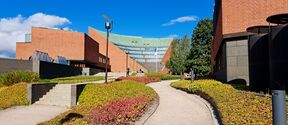Warm ice may fracture differently than cold ice

Researchers at Aalto University have found strong evidence that warm ice – that is, ice very close in temperature to zero degrees Celsius – may fracture differently than the kinds of ice typically studied in laboratories or nature. A new study published in The Cryosphere takes a closer look at the phenomenon, studied at the world’s largest indoor ice tank on Aalto’s campus.
Understanding how ice breaks is crucial for ensuring safe harbours and bridges in cool climates, as well as transportation through historically ice-heavy regions. As global warming brings changes to once-predictable seasonal conditions, the rules underpinning infrastructure engineering are being tested across borders and continents.
‘We need to study warm ice because it’s what we’re seeing in nature; global warming is happening. The mechanical properties of ice and how it responds to force may be fundamentally different when it’s warm rather than cold, as we traditionally study it,’ says Iman El Gharamti, lead author of the paper and doctoral student at Aalto University.

To study how warm ice responds to repeated rounds of force – known in the field as cyclical mechanical loading, which simulates conditions in nature – the team made use of Aalto University’s Ice Tank. Measuring 40 metres wide by 40 metres long, the 2.8m-deep basin is considered to be largest of its kind in the world.
Typically ice fractures are studied in small scales, often just 10-20 centimetres in length, at temperatures of -10 degrees Celsius or colder. In this study, the team used more than one-foot-thick ice sheets of fresh water measuring 3 by 6 metres. They also precisely controlled the ambient air temperature, and the ice was, in frozen terms, warm at a balmy -0.3 degrees Celsius.
With a hydraulic loading device the team applied multiple rounds of loading and unloading on the ice. Current understanding in the field suggests that ice will show viscoelastic recovery – separate from the immediate elastic response, it is a time-related, delayed elastic response – between loads, at least until the device is told to exert enough force to completely split the ice.
Under the conditions provided, however, the ice behaved in an unexpected way: it showed some elastic recovery but no significant viscoelastic recovery at all. In fact, the ice was permanently deformed.
‘What we typically see between mechanical loads is that the ice recovers – it springs back to normal formation until we intentionally apply so much force that it permanently cracks. In our research, the ice was increasingly deformed after each load and we detected no significant delayed elastic recovery,’ explains El Gharamti.
The main contributing factor seems to be the temperature of the ice. This research is the first to show warm ice may behave in a fundamentally different way than the cold ice normally studied.
‘The fact that the ice didn’t show delayed elastic response doesn’t fit our conventional understanding of how ice copes with repeated rounds of force. We believe that this is because of how the granular level of ice behaves when warm, but we still need to do more research to find out what’s going on,’ says Jukka Tuhkuri, professor of solid mechanics at Aalto University.
Polarised light makes each grain of ice visible, allowing the researchers to see where the crack runs. The results show that the crack ran through the grain rather than along grain boundaries.
As warmer conditions are increasingly expected in previously frigid regions like the Great Lakes or Baltic Sea – one of the world’s busiest marine areas – Tuhkuri says its crucial to understand the mechanics of warm ice.
‘A long-term ice load measurement on an icebreaker in the Baltic Sea has previously shown, surprisingly, that the largest ice load occurred during spring, when weather warms up. If our ships and infrastructure like bridges and wind turbines have been designed for fairly predictable seasons, we need to know what happens when global warming brings new conditions. It looks like the old rules may not hold up,’ Tuhkuri says.
The findings will be published in The Cryosphere on Thursday 27 May.
Full citation: Gharamti, I. E., Dempsey, J. P., Polojärvi, A., and Tuhkuri, J.: Creep and fracture of warm columnar freshwater ice, The Cryosphere, 15, 2401–2413, https://doi.org/10.5194/tc-15-2401-2021, 2021.
Resources
- Read the paper in The Cryosphere on 27 May (pre-print available)
- See related findings published in Acta Materialia.
Contact information
Read more news

Lost in the campus?
You know where to find the up-to-date campus map.
The School of Business renews its status as a Champion member of the global PRME network for sustainability education for 2026–2027
Only two other Nordic universities were awarded Champion-level membership
Unite! Seed Fund 2026: Open for applications
The 2026 Unite! Seed Fund call is officially open, offering funding across three strategic lines: Student Activities, Teaching and Learning, and Research and PhD. Deadline for applications is 20 March 2026.






